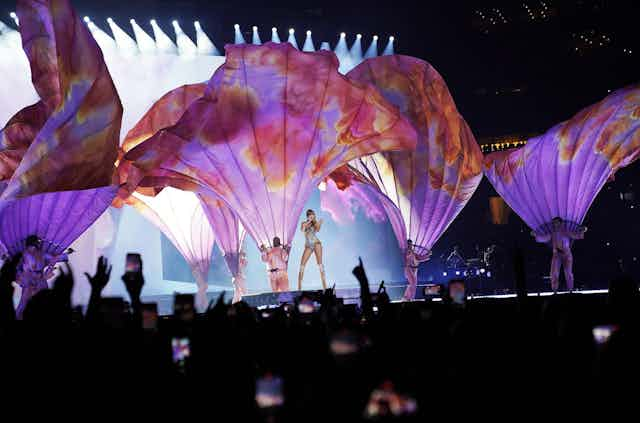The ticket scramble for Taylor Swift’s latest tour has caused such a furore that even the likes of Nobel prize-winning economist Paul Krugman have weighed in on it.
The shows on the Eras tour, which runs until August 2024, are undoubtedly expensive. And the sales process has been chaotic. On the day tickets went on sale in the US, the Ticketmaster website crashed – the company had prepared itself for 1.5 million fans, only to find that 15 million logged on.
But Swifties – the most dedicated of Swift’s fans – were willing to endure a process that was, to say the least, complicated. Ticket prices can depend on how close to the stage fans want to get and what VIP add-ons they agree to, reportedly ranging from £78 to £600 for a single ticket for the London shows.
Krugman argued that, comparatively speaking, the shows were good value. For the money, fans gained access not just to Swift’s live performance, but to the full panoply of technological effects that are an integral part of stadium gigs in the 21st century.
One can imagine Swift’s fans, some of whom spent days online (and a fair amount of money) trying to get tickets, greeting his argument with an exasperated sigh. However, he does have a point. Any ticket for the Eras tour gives its bearer access, not just to their favourite artist, but to a show that is one of the most technologically advanced of recent times.
Large-scale performances like the Eras tour have tended not to feature in academic discussions of popular music. Thankfully, this is changing. Academics like me have investigated the development of live music in Britain and the US.
Studies have examined particular types of performance (in arenas and festivals); looked at particular genres (metal, glam rock and K-pop, for example); and explored the work of individual artists (such as Lady Gaga and Prince). However, as yet, we have not dealt with these performances as theatre – as events designed to connect artist and audience, even in the largest venues.
Big blockbuster stadium shows
Since the 1970s, successful bands and artists have found a number of ingenious ways to construct shows that can fill the most cavernous arenas. The Eras tour is part of a stellar lineage that includes The Rolling Stones’ unfolding lotus set (1975-6); Pink Floyd’s The Wall (1980); the various MTV-influenced 1980s stage sets designed for Prince, Madonna and Michael Jackson; U2’s Zoo TV; and big-spectacle contemporary sets like The Weeknd’s After Hours Til Dawn tour from 2022.
The technology used on these tours serves two purposes. First, it ensures that the artist can be heard and seen, even in the largest venues. Second, it transforms the space into a setting that reflects the audience’s perception of the artist: their music, their public persona, their history – all the raw material audiences use to fuel their fandom.
In Swift’s case, that transformation is signalled in the name of the tour. The technology used on the Eras show enables both the artist and the audience effectively to travel through time.
The show is arranged around each one of Swift’s ten albums. As it moves from album to album, the stage transforms (white frames and primary colours for the Lover-era songs, snake motifs for the Reputation tracks, red costuming and stage lighting for Red, a cottage backdrop for Folklore.
The audience is part of the spectacle: LED wristbands, cued by radio signals, illuminate the crowd in dramatically sequenced floods of colour. Carefully positioned IMAG (image magnification) screens carry Swift’s image and the imagery associated with her music. The catwalk and the two secondary stages (commonly termed B stages) are themselves digital display screens. At one point Swift seems to dive into the B stage. Her digital image swims the length of the catwalk, and she reappears on the main stage as the song Lavender Haze begins.
The technology delivers all the spectacle needed to hold the audience’s attention as the three-hour show runs through Swift’s career. But it also delivers something else – something rather more unexpected.

As Swift starts the second verse of Anti Hero, an image of her dressed in the dowdy T-shirt and jeans she wears in the video swells to massive proportions on the giant screen at the rear of the main stage. She gingerly steps over tiny buildings, bats away intrusive helicopters and stares directly out at the audience, her face in huge close-up.
The song documents Swift’s insecurities; her face, magnified, has a trapped expression and she looks uncertain as her eyes sweep over the crowd. This moment of vulnerability and intimacy echoes others; moments where spotlights isolate the singer, or where the camera catches her in apparent joyous abandon, or reaching out and interacting with the crowd.
In gigs like this, technology earns back its cost, both by filling the space and by compressing it, creating an experience both spectacular and personal. Arenas and stadiums are designed for function, rather than aesthetics; they are not in themselves intimate spaces.
For Swift, the tickets her fans fight over help pay for technologies that transform the barest of venues into places where she and her fans can meet, connect and celebrate the history they share together.

